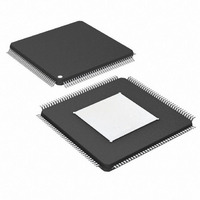DS26303LN-120+ Maxim Integrated Products, DS26303LN-120+ Datasheet - Page 62

DS26303LN-120+
Manufacturer Part Number
DS26303LN-120+
Description
IC LIU E1/T1/J1 3.3V 144-ELQFP
Manufacturer
Maxim Integrated Products
Type
Line Interface Units (LIUs)r
Datasheet
1.DS26303L-120.pdf
(101 pages)
Specifications of DS26303LN-120+
Number Of Drivers/receivers
8/8
Protocol
T1/E1/J1
Voltage - Supply
3.135 V ~ 3.465 V
Mounting Type
Surface Mount
Package / Case
144-LQFP Exposed Pad, 144-eLQFP, 144-HLQFP
Maximum Operating Temperature
+ 85 C
Mounting Style
SMD/SMT
Minimum Operating Temperature
- 40 C
Lead Free Status / RoHS Status
Lead free / RoHS Compliant
6.4.5 Bipolar Violation and Excessive Zero Detector
The DS26303 detects code violations, BPV, and excessive zero errors. The reporting of the errors is done through
the pin RNEGn/CVn.
Excessive zeros are detected if eight consecutive 0s are detected with B8ZS enabled and four consecutive 0s are
detected with HDB3 enabled. Excessive zero detection is selectable when single-rail mode and HDB3/B8ZS
encoding/decoding is selected.
The bits in the
functionality:
Table 6-9. BPV, Code Violation, and Excessive Zero Error Reporting
6.4.6 LIU Receiver Front-End
It is recommended that the receiver be configured as per
the receiver front end can be selected by register GC.RIMPMS. When this bit is set to external mode the user is
required to supply two 15Ω resistors (Rt) as shown in
will still be set in external mode if 75Ω, 100Ω, or 110Ω impedance is selected during template selection. However,
the internal 30Ω resistor will be disconnected. If the user would like all the adjust resistors to be disconnected or
any internal impedance matching, then the user should set the TS.RIMPOFF bit for each LIU or the RIMPOFF pin
when in hardware mode.
6.5 Hitless-Protection Switching (HPS)
Many current redundancy protection implementations use mechanical relays to switch between primary and
backup boards. The switching time in relays is typically in the milliseconds, making T1/E1 HPS impossible. The
switching event likely causes frame-synchronization loss in any equipment downstream, affecting the quality of
service. The same is also true for tri-stating mechanisms that use software or inactive clocks for the triggering of
HPS.
The DS26303 LIU includes fast tri-statable outputs for TTIPn and TRINGn and fast turn-off impedance matching for
the RTIPn and RRINGn within less than one bit cycle. The control logic is shown in
the user can set the RHPMC bit, which allows the OE pin to control both the transmitter outputs and the receive
impedance matching. This is a very useful function in that control can be done through a hardware pin, allowing a
quick switch to the backup system for both the receiver and the transmitter.
application in software mode where the OE pin is used for control. In hardware mode, the receiver can have
impedance matching turned off quickly by using the RIMPOFF pin, and the transmitter output can be turned off
quickly by using the OE pin.
EZDE is reset, CVDEB is reset
EZDE is set, CVDEB is reset
EZDE is reset, CVDEB is set
EZDE is set, CVDEB is set
CONDITIONS
EZDE
and
CVDEB
registers determine the combinations that are reported.
BPV + code violation + excessive zero
BPV + excessive zero
BPV + code violation
CVn PIN REPORTS
DS26303: 3.3V, T1/E1/J1, Short-Haul, Octal Line Interface Unit
62 of 101
Figure
BPV
Table 6-4
6-4. The internal adjust resistors A75, A100, and A110
and
Figure
6-4. Internal or external mode for
Figure 6-6
Figure
6-5. In software mode,
Table 6-9
shows a typical HPS
outlines the












